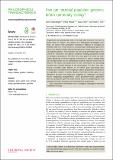| dc.contributor.author | VanInsberghe, David Stephen | |
| dc.contributor.author | Arevalo, Philip Alexander | |
| dc.contributor.author | Chien, Diana M. | |
| dc.contributor.author | Polz, Martin F | |
| dc.date.accessioned | 2020-07-10T19:03:14Z | |
| dc.date.available | 2020-07-10T19:03:14Z | |
| dc.date.issued | 2020-03 | |
| dc.date.submitted | 2019-12 | |
| dc.identifier.issn | 0962-8436 | |
| dc.identifier.issn | 1471-2970 | |
| dc.identifier.uri | https://hdl.handle.net/1721.1/126138 | |
| dc.description.abstract | Populations are fundamental units of ecology and evolution, but can we define them for bacteria and archaea in a biologically meaningful way? Here, we review why population structure is difficult to recognize in microbes and how recent advances in measuring contemporary gene flow allow us to identify clearly delineated populations among collections of closely related genomes. Such structure can arise from preferential gene flow caused by coexistence and genetic similarity, defining populations based on biological mechanisms. We show that such gene flow units are sufficiently genetically isolated for specific adaptations to spread, making them also ecological units that are differentially adapted compared to their closest relatives. We discuss the implications of these observations for measuring bacterial and archaeal diversity in the environment. We show that operational taxonomic units defined by 16S rRNA gene sequencing have woefully poor resolution for ecologically defined populations and propose monophyletic clusters of nearly identical ribosomal protein genes as an alternative measure for population mapping in community ecological studies employing metagenomics. These population-based approaches have the potential to provide much-needed clarity in interpreting the vast microbial diversity in human and environmental microbiomes. This article is part of the theme issue 'Conceptual challenges in microbial community ecology'. | en_US |
| dc.description.sponsorship | National Science Foundation (Grant NSF1831730) | en_US |
| dc.language.iso | en | |
| dc.publisher | The Royal Society | en_US |
| dc.relation.isversionof | http://dx.doi.org/10.1098/rstb.2019.0253 | en_US |
| dc.rights | Creative Commons Attribution 4.0 International license | en_US |
| dc.rights.uri | https://creativecommons.org/licenses/by/4.0/ | en_US |
| dc.source | The Royal Society | en_US |
| dc.title | How can microbial population genomics inform community ecology? | en_US |
| dc.type | Article | en_US |
| dc.identifier.citation | VanInsberghe, David et al. "How can microbial population genomics inform community ecology?." Philosophical Transactions of the Royal Society B: Biological Sciences 375, 1798 (March 2020): 20190253 © 2020 The Authors | en_US |
| dc.contributor.department | Massachusetts Institute of Technology. Department of Civil and Environmental Engineering | en_US |
| dc.relation.journal | Philosophical Transactions of the Royal Society B: Biological Sciences | en_US |
| dc.eprint.version | Final published version | en_US |
| dc.type.uri | http://purl.org/eprint/type/JournalArticle | en_US |
| eprint.status | http://purl.org/eprint/status/PeerReviewed | en_US |
| dc.date.updated | 2020-06-01T17:16:28Z | |
| dspace.date.submission | 2020-06-01T17:16:31Z | |
| mit.journal.volume | 375 | en_US |
| mit.journal.issue | 1798 | en_US |
| mit.license | PUBLISHER_CC | |
| mit.metadata.status | Complete | |
